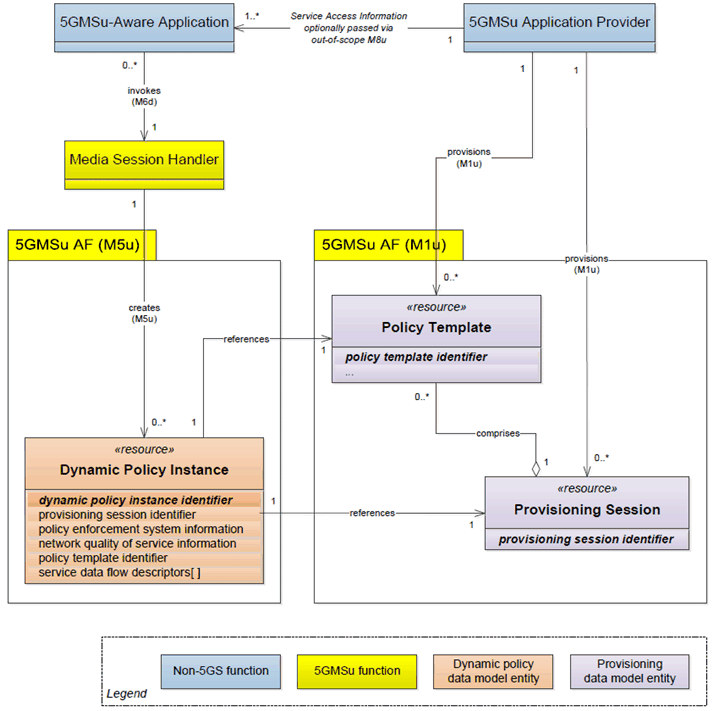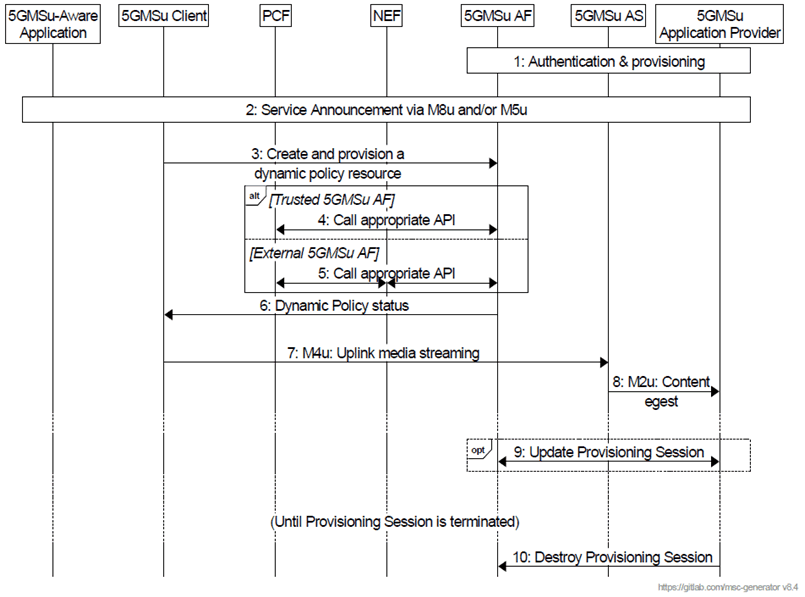Content for TS 26.501 Word version: 18.6.0
1…
4…
4.0.6…
4.1…
4.2…
4.2.2…
4.3…
4.4
4.5…
4.6…
4.7…
4.7.4…
4.8
4.9…
4.10…
5…
5.2…
5.2.4
5.2.5…
5.3…
5.3.2…
5.4…
5.5…
5.6…
5.7…
5.7.4…
5.7.8
5.8…
5.10…
5.10.5…
5.10.6…
5.11…
5.12…
5.12.4…
5.12.5…
6…
6.2…
6.2.2.2…
6.2.3…
6.3…
6.4…
6.8…
6.9…
6.9.5…
6.9.7
7…
8…
9…
A…
A.4…
A.8
A.9
A.10
A.11
A.12
A.13
A.14
A.15…
A.15.3…
B…
B.3
C…
C.3
C.4
C.5
D…
E…
6.9 Establishing an uplink streaming session with 5GMSu AF interactions for dynamic policy invocation and updates
6.9.1 General
6.9.2 Provisioning
6.9.3 Uplink streaming with dynamic policy invocation
6.9.4 Parameters for dynamic policy invocation configuration
...
...
6.9 Establishing an uplink streaming session with 5GMSu AF interactions for dynamic policy invocation and updates |R18| p. 174
6.9.1 General p. 174
This clause describes the procedures for provisioning Policy Templates and the establishment of uplink streaming session using dynamic policy invocation. The establishment of the uplink streaming session uses 5GMSu AF interactions, as described in clause 6.1. The Dynamic Policy feature allows separate handling of Service Data Flows within the same PDU Session. The Media Session Handler provides a Policy Template Id together with Service Data Flow Descriptions when requesting a dynamic policy. An example Policy Template Id value is "background_data".
The Media Session Handler provides needed information to the 5GMSu AF, so that the 5GMSu AF can combine the semi-static parameters from a Policy Template (which is associated with the Policy Template Id) with parameters supplied dynamically by the Media Session Handler to trigger a dynamic PCC rule update using the NEF or PCF.
The 5GMSu AF may trigger, for example, the "AF session with required QoS procedure" (see clause 4.15.6.6 of TS 23.502) to update QoS-related dynamic PCC rules. For changing charging-related rules, the 5GMSu AF may trigger the "Change the chargeable party during the session" procedure (see clause 4.15.6.5 of TS 23.502).
6.9.2 Provisioning p. 174
The provisioning for the dynamic policy procedure follows the general procedure from clause 6.2.2. Specifically, the Dynamic Policy feature is activated and, as result, the 5GMSu Application Provider is able to provision one or more Policy Templates.
The domain model of M1u and M5u APIs is depicted in Figure 6.9.2-1. Realization of the dependencies between M1u and M5u data entries are up to implementation.

Figure 6.9.2-1: Domain model for dynamic policies for uplink streaming
(⇒ copy of original 3GPP image)
(⇒ copy of original 3GPP image)
A Policy Template is identified by a Policy Template Id and contains semi-static parameters, including the API entry for the PCF/NEF interactions. The list of provisioned Policy Template Ids is communicated as valid Policy Template Ids to the Media Session Handler. The Media Session Handler uses one of the valid Policy Template Ids when invoking a dynamic policy.
6.9.3 Uplink streaming with dynamic policy invocation p. 176
This procedure describes the establishment of an uplink streaming session with 5GMSu AF interactions for dynamic policy invocation.

Figure 6.9.3-1: High-level procedure for uplink media streaming session with dynamic policy invocation
(⇒ copy of original 3GPP image)
(⇒ copy of original 3GPP image)
Steps:
Step 1.
Then:
The 5GMSu Application Provider authenticates and provisions the 5GMS System for uplink media streaming.
Step 2.
The 5GMSu Application Provider provides the Service Access Information to the 5GMSu-Aware Application via reference point M8u, or alternatively the 5GMSu Client acquires the Services Access Information from 5GMSu AF via reference point M5u.
Step 3.
Optionally:
The 5GMSu Client requests that a dynamic policy is applied to the media streaming session. The request includes at least the Provisioning Session identifier, the Service Data Flow Description(s) and the Policy Template identifier (see Figure 6.9.2-1), to be applied to the described transport session. In some cases, a QoS specification is also provided, containing desired QoS information. The 5GMSu AF uses the Policy Template for the related procedure and to identify the related network function.
Step 4.
This step applies when the 5GMSu AF resides in the trusted Data Network. Depending on the Policy Template, the step is executed either:
Step 5.
-
When the Policy Template relates to QoS, the 5GMSu AF may either directly interact with the PCF or may use a NEF service:
-
when directly interacting with the PCF, the 5GMSu AF uses the Npcf_
PolicyAuthorization service as defined in clause 5.2.5.3 of TS 23.502). - when interacting via the NEF with the PCF, continue at step 5a.
-
when directly interacting with the PCF, the 5GMSu AF uses the Npcf_
-
When the Policy Template relates to a different charging scheme, the 5GMSu AF may either directly interact with the PCF or may use a NEF service:
-
when directly interacting with the PCF, the 5GMSu AF uses the Npcf_
PolicyAuthorization service as defined in clause 5.2.5.3 of TS 23.502). - when interacting via the NEF with the PCF, continue at step 5b.
-
when directly interacting with the PCF, the 5GMSu AF uses the Npcf_
This step applies when the 5GMSu AF resides in the external Data Network. Depending on the Policy Template, the step is executed either:
Step 6.
-
When the Policy Template relates to QoS, the 5GMSu AF uses the Nnef_
AFsessionWithQoS service as defined in clause 5.2.6.9 of TS 23.502. (The complete call flow is described in clause 4.15.6.6 of TS 23.502.) -
When the Policy Template relates to a different charging scheme, the 5GMSu AF uses the Nnef_
ChargeableParty service as defined in clause 5.2.6.8 of TS 23.502. (The complete call flow is described in clause 4.15.6.4 and 4.15.6.5 of TS 23.502.) The Policy Template may contain Sponsor Information (values based on SLA negotiation) and a Background Data Transfer Reference ID. The Flow Description is provided by the Media Session Handler at API invocation.
The response to step 3 from the 5GMSu AF contains status information (policy accepted, rejected, etc) and information on policy enforcement such as the enforcement method and enforcement bit rate.
Step 7.
The 5GMSu Client streams the content to the 5GMSu AS via reference point M4u.
Step 8.
When content publishing is offered and has been selected in step 1, the content contributed to the 5GMSu AS in the previous step is made available to the 5GMSu Application Provider via reference point M2u.
Step 9.
According to schedule, or upon request by the 5GMSu-Aware Application:
The 5GMSu Application Provider may update the Provisioning Session.
Step 10.
The 5GMSu Application Provider may manually terminate the Provisioning Session (at any time). All associated resources are released. Content may be removed from the 5GMSu AS. The 5GMSu Application Provider may configure a schedule for Provisioning Session termination.
6.9.4 Parameters for dynamic policy invocation configuration p. 177
| Parameters | Description |
|---|---|
| Policy Enforcement | Information about the policy enforcement system. |